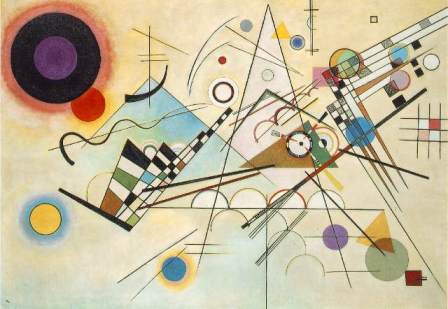In 1921, Kandinsky and his wife, Nina, moved back to Germany. The couple spent six months in Berlin, and then moved to Weimar, where Walter Gropius had offered Kandinsky a teaching job at the Bauhaus. He as to run a mural painting workshop, and produced several massive murals during this time. The paintings themselves no longer exist, but preliminary studies have survived. In 1977, many of these murals were reconstructed by the Musee d’Art Moderne in Paris. The murals belong to the style of the last works created by Kandinsky in Russia, in their brilliant colors and mystical, almost oriental colors. Their abstract nature geometric forms also look ahead to the balanced, more formal works that would characterize his later Bauhaus years.
Two examples of the murals follow below:
Small Worlds II (1922)
In some of the other murals from that time period, the same black background with color in the foreground featured in one of Bely’s paintings can be found.
The Bauhaus was actually a very appropriate place for Kandinsky to teach, as it was an establishment that rejected traditional Academy methods of art education in favor of theoretical and practical training in a wide range of skills. Men and women were accepted equally as artists. At the Bauhaus, Kandinsky worked with other luminaries such as Pul Klee and Oskar Schlemmer.
Kandinsky considered one of his most important works of the post-war years Composition VIII (1923), seen below. A strict geometry is formed in this painting, and Kandinsky converts his landscape motifs into the abstract style of his post-Russian years. It is also the first systematic application of Kandinsky’s thoughts on colors and forms and the relationships between them: he uses warm yellow and cold blue as the fundamental polarities, and uses the circle and triangle as contrasting elements symbolizing movement (triangle) and stability (circle). (Taschen, Benedikt. p. 141.)

Composition VIII (1923)
The work critics consider the most important of Kandinsky’s Weimar period is Yellow-Red-Blue (1925), found below. Its underlying structure is determined by the three primary colors, which are shaded from light (left) to dark (red), just as on a color chart. However, the diversity of forms present in the painting create a complex structure of color relationships. (Taschen p. 141)
Yellow-Red-Blue (1925)
The rest of the Bauhaus years were spent primarily in investigation of different aspects of points and lines. Kandinsky investigated first the point, then the straight line, then the curve, largely in black and white. Through these exercises, Kandinsky expanded upon his concept of a free play of forms according to strict internal laws. He then leaned toward strict geometric forms, as opposed to simply lines. Between 1926 and 1929, the chief pictorial element and geometrical form was the circle. Circles achieved the mystic importance previously enjoyed by the rider. Kandinsky found in circles more inner possibilities than in horses, and Kandinsky wrote to Will Grohmann about this in 1930:
“…It is not the ‘geometrical’ form of the circle [that causes its frequent use], but rather my own sensitivity to the inner force of the circle in all its countless variations. I love circles today in the same way that previously I loved, e.g. horses – perhaps even more so, since I find in circles more inner possibilities, which is hte reason why the circle has replaced the horse. All this has, I have already mentioned, no role to play in the course of working; I do not choose form consciously, it chooses itself within me.”
These sentiments are very much linked to the ways in which anthroposophists sought higher knowledge. It was created both from available elements in the outside world and from within oneself, as one aspired to reach a higher spiritual plane.
In this search for a more meaningful spirituality, Kandinsky combined art forms. In 1928, the director of the Friedrich Theatre in Desau invited Kandinsky to design sets to accompany a performance of Modest Mussorgsky’s Pictures at an Exhibition. This involved transposing Mussorgsky’s composition, which had itself been inspired by paintings, back into visual media. Mussorgsky’s music offered an abstract rendition of the composer’s innermost feelings and reactions regarding the exhibition he saw; Kandinsky’s paintings were an abstract visual rendition of heard music.